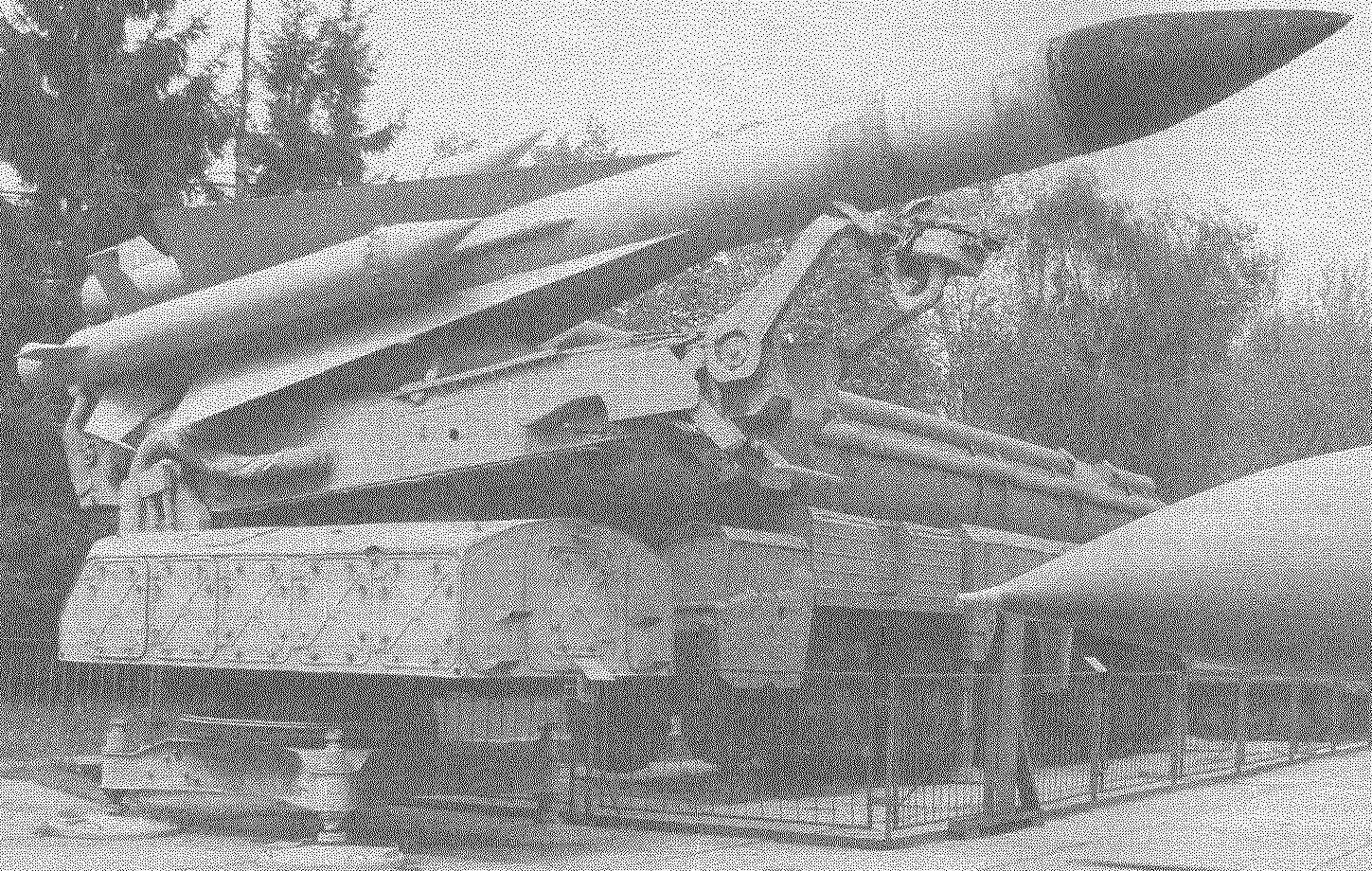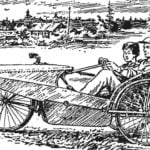 The adoption in December 1957 adopted the first option anti-aircraft missile system s-75 allowed her the lead developers of KB-1 A. A. Raspletin and OKB-2 PD Grushin to start the creation of air defense systems long range. By that time, similar developments were enough American “Bomark” English “Thunderbird”, the Soviet “Dal” the New system received the designation C-200, and a government decree authorizing its development was signed on 4 June 1958.
The adoption in December 1957 adopted the first option anti-aircraft missile system s-75 allowed her the lead developers of KB-1 A. A. Raspletin and OKB-2 PD Grushin to start the creation of air defense systems long range. By that time, similar developments were enough American “Bomark” English “Thunderbird”, the Soviet “Dal” the New system received the designation C-200, and a government decree authorizing its development was signed on 4 June 1958.
“Dvuhletki” was not a direct competitor, “Given”, which in the spring of 1955 was conducted in OKB-301 Lavochkin. A number of new requirements are largely predetermined and the differences created for these systems the missiles. The main difference is-860 (such designation received by the missile for s-200) from the rocket 13D was the use of semi-active homing (GOS), the development of KB-1, is able to capture the objective even while rocket on the launcher. This allowed us to radically improve the accuracy of homing and increase the reliability of the action of the rocket by simplifying its on-Board equipment and ground-based.
Based on In-860 picked up a rocket-850, prorabatyvayutsya shortly before for a failed system-175 rocket of normal aerodynamic configuration with wings of small aspect ratio with side solid-fuel boosters and a sustainer stage with a rocket engine. This arrangement not only minimize the design, but also the size of the rocket, However, it wasn’t perfect. That was worth at least the problem of simultaneous separation of the four boosters after the acceleration of the rocket to supersonic speed. In this case, even small differences in their thirst could lead to the complete destruction of the rocket. Not much simpler than was the case with the selection of the type of the main engine. That time traditional option.
missiles with LRE had the necessary traction-gugenot to ensure the missile to the desired range and it performed maneuvers in the zone of interception. However, as the final version with expander adopted only after numerous comparisons with fully solid and sustainer ramjet motor.
His contribution to the selection of the type of the main engine made calculations according to which for obtaining the maximum range much of the time the rocket was moving at high altitudes, the trajectories close to ballistic. The mode of such a flight provided that the fuel consumption had to be made so that by the time the meeting aimed to realize the maximum value of the average speed of a missile. Its weight by this time was minimal, and maneuverability — maximum. In those years, such a regime could be implemented by just using rocket engines that can change the pulling force by almost three times.
Search developer LRE has led specialists of OKB-2 in Leningrad, in the KB, headed by A. S. Mavicom that Avalos branch of engine plant No. 500. And the people of Leningrad, not without doubt who undertook the difficult task, did not disappoint, creating in the shortest possible time LRE 5Д12 with required characteristics.
Another “highlight” of the new missile was to ensure the effectiveness of the rudders in an extremely wide range of flight conditions, the pressure of the incoming air flow was changed dozens of times, and the speed from subsonic to hypersonic. Faced with this in the very early stages of design OKB-2 “tried on” to the new rocket all previously used options are the mechanism of change of gear ratio (iidh) and spring compensators. But this time it was required a different and, ultimately, the solution, is also caught in the Treasury of masterpieces of engineering. Proposed in OKB-2 wheels (more precisely, the control surfaces-ailerons) was trapezoidal, and was composed of two parts with a torsion-connected. Such a clever mechanical design, the growth of dynamic pressure under the same deviation value smaller root of the steering wheel provide automatic reduction of the angle of rotation the greater part of the helm.
Another problem, which manifested itself in the early stages of design-860, was energy missiles, as the bulk of the circuitry on-Board equipment was vacuum tubes and accompany them to the device. Equally heavy and cumbersome it gets and the battery is able to saturate a missile of electricity.

Rocket 5В21В automatic charging machine 5Ю24
To do without them, the missile was to equip a kind of mini-power plant, consisting of generator, converters and gas turbines. The hot gas for its operation could be obtained due to the decomposition of any single component fuel. But in this case, the mass of the power plant for In-860 exceeded all conceivable limits. However, in the first sketch project took such a decision. And after some time spent one variant provides for the use of components of plant primary fuel.
The solution turned out to be perfect, not requiring the installation of additional tanks, a special device them the boost, fueling and draining.
So step by step, loomed In 860 and lined up a chain of its future developers.
And this time, the OKB-2 was tried to maintain his credo wildest ideas should be implemented using abundant materials and relying on the technological possibilities of production. However, to completely dispense with the use of new materials and technologies could not. Titanium alloys, plastics, graphite, foam filler — that’s just a small list of new, popular V-860 material. For this missile was developed and a unique process of the contact roller welding of aluminium alloy sheets (4 mm thickness) of which manufactured the fuel tanks.
And still in first place for its uniqueness should put a radio-transparent fairing, which for the first time in the country developed and implemented in the production of large multi-function design based on fiberglass.
In the early summer of 1960 g-860 (factory designation 1F) went to the landfill. As usual, the first missile was intended for throwing launches and were equipped with dimensions and weight mock blocks of equipment, main engine and, of course, seeker. Then, over her still hard you were working at KB-1, composing hundreds of wired parts in the designated compartments of the rocket and get practicing the design on a special stand in the town of Zhukovsky in Moscow region.
The first start-860 took place on 27 July and looked truly enchanting. Testers, accustomed, seemingly, to all sorts of quirks start rockets conquered this spectacle, which lasted only a few seconds, the power and the beauty of “fire” breakthrough “860”, after which the sky is visible only a black point, like a blooming steppe Tulip — separated accelerators.
However, from barely started to fly rocket has demanded more September 12, 1960 the Military-industrial Commission (MIC) has decided to increase the far boundary of the affected area-860 from 100 to 160 km and almost equal in their capabilities with “Dal”. To solve this problem, again had to turn to waste on other rockets to the practice of using the passive part of the trajectory. But to proceed to triggers such range was only a few years — development of “dvuhsotki” was extremely difficult.


Anti-aircraft guided missile IN-860ПВ (5В21В):
1 — radio-transparent Radome of the antenna homing, 2 — instrument compartment, 3 — compartment of military equipment 4 — lifting lug for lifting the rocket; 5 — oxidizer tank, 6 — charger of the high pressure cylinder, 7 — gauge, any-400; 8 — fairing accelerator, 9 — rigging a yoke, the 10 — foot ring; 11 — a hose fuel, 12 — console wing, 13 — pipeline oxidizer; 14 — operating the hatch cover, 15 receiver full pressure air flow, 16 — gargrot; 17 — attachment wing; 18 — pipeline fuel, 19 — the moving part of the steering wheel; 20 — the root of the helm, a 21 — protivoallergennye balancer 22 — tube approach to the stop, a 23 — sides of the combustion chamber of an accelerator, 24 — stabilizer, 25 — the front attachment point of the accelerator, a 26 — manhole cover for access to the squibs of the accelerator and the power cylinder division, 27 — nozzle accelerator 28 — rear attachment point of the accelerator, a 29 — track rollers, 30 —front starter yoke
Note. The inscription on the missile, the accuracy of the text which could not be restored, made by type – XXXXXX XXX
So, despite all taken in 1961, of steps to accelerate the testing of s-200, in that year, and failed to start launches fully-equipped missiles. The report on the results of work of the State Committee on aviation technology (GKAT) in 1961, it was noted that of the 39 made missiles-860 only 22 were used for the tests, of which positive results were obtained, with 18 starts. The main causes of delays in the trials was the lack of autopilots and GOS, completion of the radio waves fairing.
Only in the early summer of 1962, the rocket won by the time designation-860П made its first start in a closed control loop, and on August 31, but without the warhead, was launched to intercept the aircraft target the Yak-25. Such “telemetry” triggers lasted more than six months. First regular start “860 th” aircraft target Il-28M was held on 10 may 1963 However, because of inaccurate matching of the characteristics of the warhead and fuse the target after a meeting with the fragments continued their flight, and had to be destroyed by other means. A month later, on June 5, the 69th launch, it worked on all hundred percent — the target of MiG-17M has completely ceased to exist.
However, prior to the adoption of IN-860П on the arms were still far away. In January 1964 the Military-industrial Commission made another series of organizational measures to accelerate the fine-tuning of the rocket and set a new deadline— II quarter of 1964, However, and at this time have been impossible to meet But by this time, despite the difficult course of complex tests associated primarily with the problems arising when developing homing missiles, the State Committee on radio electronics (GKRE) insisted on going to the joint tests. The result was a Commission under the chairmanship of the Deputy. The commander of the air defense forces of the country of the Hero of Soviet Union Colonel-General of aviation G. V. Zimin.
Joint tests began in February 1964 92-m start-860П. Already March 19, during the state tests of s-200 shot down the first target, the Tu-16M, which was at the time of launch on the distance of 113 km and an altitude of about 10 km, following the start made at a distance of about 80 km, destroyed the target, a MiG-19 flying at transonic speed at a height of 14.5 km. In June 1964 C-200 was hit by an even more challenging target of ER-35ИЦ located at the distance of 177 km and a height of over 25 km.
These results formed the basis of the report on the new system the country’s leadership, which was made during a demonstration of the latest military technology in Kubinka. After a successful demonstration of the elements of the C-200 took the decision to start construction of the first objects. At the same time continued and the state tests which, as before, walked with considerable difficulty.
Quite unexpectedly, in the winter of 1966 were added, and problems with solid-fuel boosters DWP-81. Initially, they used well-tested ballistite fuel developed by NII-125 under the leadership of B. P. Zhukov. In the process of testing modified compounds, varied sizes of pieces, but problems with their reliability did not arise, as well as which succeeded them mixed fuels, the development of which for “860” performed in Perm NII-130. Unlike ballistite, solid propellant allowed the making of charges by them pouring into the engine block. This provides a durable bond of the fuel charge with the walls of the engine housing.
Equipped the rocket flew until the beginning of 1966 when, during one of the launches, an explosion occurred. As a result, after a careful study of the causes of the incident, the rocket re-installed the accelerators, offer ballistite fuel. With them by the end of 1966 and ended the state tests of the missile in the first variant of the system s-200 “Angara”, and 22 February 1967, under the designation 5В21А missile was accepted into service.
In further conducted a number of research works to improve the rocket. So, in November of 1968 had examined the possibility of reducing the minimum height of the affected area, and in January 1969, explored the possibility of its defeat tactical ballistic missiles 8K11 and 8K14.
A number of these improvements were also linked to the fact that in its initial version, the s-200 “Angara” had insufficient noise immunity and can hit air targets only in a simple setting (under the action of continuous noise).

Rocket 5В27 on TZM 5Т83
Knowing the probable enemy had Directors active interference of wide class — off, interrupted and gone in the range and range rate, in KB-1 was conducted by the research “VEGA” to ensure the stability of the system path s-200 in terms of the interference. Soon came the decision of the military-industrial complex about carrying out development work on the modernization of the firing channel system “Angara” rocket 5В21А and development work on the rocket included the capture target homing head and its support on the trajectory when firing from the closed starting position.
For shooting channel has created a number of new blocks and reworked the part available. Upgraded firing channel allowed the use of an improved version of the missile IN-860ПВ (5В21В) with a new seeker and a radio Fuze and rocket-860П from the source system s-200. The upgraded complex has received the designation s-200V “VEGA”.
In September 1969, SAM 5В21В adopted in the system s-200V. In General, the work done has expanded the boundaries of a zone of defeat of the purposes and conditions of use of the complex.
Of course, the creation of the s-200 did not solve all the problems raised by life in front of developers, and soon there was a need for more radical improvement “dvuhsotki”. It reached the interception range of 160 km (180 km of the option “VEGA” rocket 5В21) was again inadequate, especially after reports emerged about a US nuclear aircraft missiles SRAM. It was possible to run with strategic bombers at a distance of over 200 km For developers of air defense systems meant that the boundary of the fight against bombers needed push for several tens of kilometers. And after a few years the task of the developers was solved.
Basic data rocket-860ПВ (5В21В)
Length, m……………………………………………………………..10,8
The diameter of the sustainer stage, m……………………………..0,75
The wingspan of the sustainer stage, m…………………..2,7
Launch weight, kg……………………………………………..6700
The warhead…………………………………………………high-explosive with the finished pieces
Warhead weight, kg…………………………………………220
The affected area in range, km………………………..17-180
The affected area height, km……………………………..0,3 -35,0
The maximum speed of the targeted objectives, km/h….4300
V. KOROVIN



